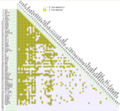UNIFAC consortium
The UNIFAC consortium was founded by Jürgen Gmehling at the Carl von Ossietzky University of Oldenburg at the Chair of Technical Chemistry to invite private companies to support the further development of the group contribution methods UNIFAC and its successors. The methods essentially serve to estimate thermodynamic properties, especially to predict phase equilibria .
The UNIFAC consortium is a successful example of the support of a public institution by private donors.
history
The UNIFAC industrial consortium was founded in 1997 when it became foreseeable that public funding for model development would not continue. Since UNIFAC and its successor, mod. UNIFAC (Dortmund), which has already been used to a large extent in the industry in the areas of process simulation and process synthesis , there were clear indications from the research and development departments of these companies that they were willing to support this consortium.
The consortium is supported (as of September 2008) by more than 40 companies, including AkzoNobel , Arkema , BASF , Ciba , Cognis , Dow , DSM , DuPont , Eastman , Evonik , ExxonMobil , GlaxoSmithKline , Hoffmann-La Roche , LyondellBasell , Mitsui Chemicals , Mitsubishi Chemicals , Repsol YPF , Rhodia , SABIC , Shell , Sasol , Sumitomo Chemical and Wacker Chemie . In addition to these large companies, some smaller engineering companies and university groups are also members of the consortium.
The company DDBST GmbH plays a special role. This is made available free of charge by the Dortmund database (DDB) and some software. The DDB, a fact database for thermodynamic data, especially phase equilibria, is the most important working basis of the consortium.
Consortium objectives
The work of the consortium consists essentially of
- creating new and improving old model parameters
- the measurement of experimental data (partly in-house, partly through contract award)
- holding an annual sponsors' meeting
For example, the consortium has changed and added 404 interaction parameters of the UNIFAC model compared to the last publication.
- Interaction parameters of the UNIFAC model
The main goals are
- Improvement of the forecast quality,
- To improve the applicability of the models. In particular, this includes support for additional components with new functional groups.
- make the parameters for process simulation software and the DDB software available (only for consortium members)
The parameters created in the consortium are confidential and only accessible to members for two and a half years after the first delivery. After this time, the university working group can publish the parameters.
Supported models
The UNIFAC consortium develops parameters for three models:
- modified UNIFAC (Dortmund)
- original UNIFAC
- PSRK (since 2005).
Both UNIFAC models calculate activity coefficients, while PSRK is a combination of a slightly modified UNIFAC with an equation of state .
Individual evidence
- ^ Wittig R., Lohmann J., Gmehling J., “Vapor-Liquid Equilibria by UNIFAC Group Contribution. 6. Revision and Extension ", Ind.Eng.Chem.Res., 42 (1), 183-188, 2003
- ↑ Weidlich U., Gmehling J., "A Modified UNIFAC Model. 1. Prediction of VLE, hE, and gamma Infinite", Ind.Eng.Chem.Res., 26 (7), 1372-1381, 1987
- ↑ Fredenslund A., Jones RL, Prausnitz JM, "Group-Contribution Estimation of Activity Coefficients in Nonideal Liquid Mixtures", AIChE J., 21 (6), 1086-1099, 1975
- ↑ Å. Fredenslund, J. Gmehling, P. Rasmussen; "Vapor-Liquid Equilibria Using UNIFAC - A Group Contribution Method;" Elsevier, Amsterdam (1977)
- ↑ Holderbaum T., Gmehling J., "PSRK: A Group-Contribution Equation of State based on UNIFAC", Fluid Phase Equilib., 70, 251-265, 1991


